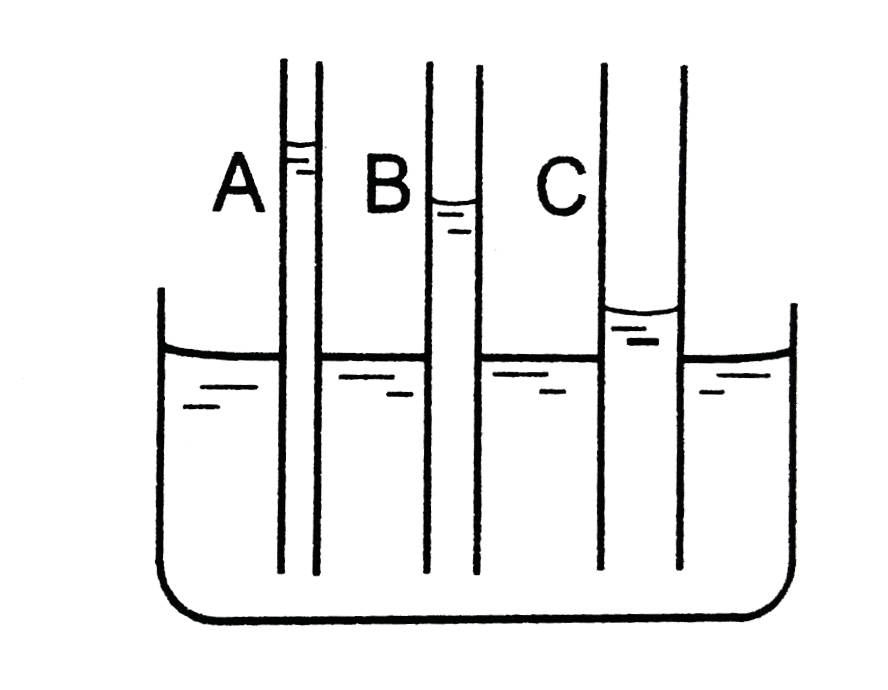Two long capillary tubes of diameter mm and mm are held vertically inside water one by one . How much high the water will rise in each tube ? ( , surface tension of water N/m)
To solve the problem of how high water will rise in two capillary tubes of different diameters, we can use the formula for the height of liquid rise in a capillary tube, which is given by:
h=2Tcosθρgr
Where:
- h = height of the liquid column
- T = surface tension of the liquid (water in this case)
- θ = contact angle (for water in a clean glass tube, it is approximately 0 degrees, so cosθ=1)
- ρ = density of the liquid (for water, ρ=1000kg/m3)
- g = acceleration due to gravity (given as 10m/s2)
- r = radius of the capillary tube
1. Identify the given values:
- Diameter of the first tube, d1=5.0mm=0.005m
- Diameter of the second tube, d2=4.0mm=0.004m
- Surface tension of water, T=7.0×10−2N/m
- Density of water, ρ=1000kg/m3
- Acceleration due to gravity, g=10m/s2
2. Calculate the radius of each tube:
- For the first tube:
r1=d12=0.0052=0.0025m
- For the second tube:
r2=d22=0.0042=0.002m
3. Calculate the height of water rise in the first tube:
- Substitute the values into the formula:
h1=2Tcosθρgr1
h1=2×(7.0×10−2)×11000×10×0.0025
h1=0.1425
h1=0.0056m=5.6mm
4. Calculate the height of water rise in the second tube:
- Substitute the values into the formula:
h2=2Tcosθρgr2
h2=2×(7.0×10−2)×11000×10×0.002
h2=0.1420
h2=0.007m=7.0mm
Final Results:
- The height of water rise in the first tube (5.0 mm diameter) is 5.6 mm.
- The height of water rise in the second tube (4.0 mm diameter) is 7.0 mm.
- h = height of the liquid column
- T = surface tension of the liquid (water in this case)
- θ = contact angle (for water in a clean glass tube, it is approximately 0 degrees, so cosθ=1)
- ρ = density of the liquid (for water, ρ=1000kg/m3)
- g = acceleration due to gravity (given as 10m/s2)
- r = radius of the capillary tube
- Diameter of the first tube, d1=5.0mm=0.005m
- Diameter of the second tube, d2=4.0mm=0.004m
- Surface tension of water, T=7.0×10−2N/m
- Density of water, ρ=1000kg/m3
- Acceleration due to gravity, g=10m/s2
- For the first tube:
r1=d12=0.0052=0.0025m
- For the second tube:
r2=d22=0.0042=0.002m
- Substitute the values into the formula:
h1=2Tcosθρgr1
h1=2×(7.0×10−2)×11000×10×0.0025
h1=0.1425
h1=0.0056m=5.6mm
- Substitute the values into the formula:
h2=2Tcosθρgr2
h2=2×(7.0×10−2)×11000×10×0.002
h2=0.1420
h2=0.007m=7.0mm
- The height of water rise in the first tube (5.0 mm diameter) is 5.6 mm.
- The height of water rise in the second tube (4.0 mm diameter) is 7.0 mm.
Similar Questions
A capillary tube of radius 0.25 mm is submerged vertically in water so that 25 mm of its length is outside water. The radius of curvature of the meniscus will be
(surface tension of water =75×10−3 N/m)View SolutionWater rises in a capillary tube to a height of 2.0cm. In another capillary tube whose radius is one third of it, how much the water will rise?
View Solution
Knowledge Check
- Question 1 - Select One
Water rises in a capillary tube to a height of 2.0cm. In another capillary tube whose radius is one third of it, how much the water will rise?
A5 cmB3 cmC6 cmD9 cm
Water rises in a capillary tube to a height of 2.0cm. In another capillary tube whose radius is one third of it, how much the water will rise?
View SolutionA capillary tube of radius 0.20 mm is dipped vertically in water. Find the height of the water column raised in the tube. Surface tension of water =0.075Nm−1 and density of water =1000kgm−3.Takeg=10ms−2.
View SolutionTwo vertical glass plates 1 mm apart are dipped into water. How high will the water rise between the plates. If the surface tension of water is 70 dyne cm−1
View SolutionA capillary tube of inside diameter 1mm is dipped vertically into water, so that the length of its part protruding over the water surface is 20mm.What is the radius of curvatur of the meniscus ? Surface tension of water is 72×10−3N/m.
View SolutionThe capillaries shown in figure have inner radii 0.5 mm, 1.0 mm and 1.5 mm respectively. The liquid in the beaker is water. Find the heights of water level in the capillaries. The surface tension of water is 7.5×10−2Nm−1.
 View Solution
View Solutionwater rises in a capillary tube to a height of 1 cm. In another capillary where the radius is one-third of it, how high will the water rise (in cm)?
View SolutionFind the pressure inside an air bubble of radius 1 mm at a depth of 20 m in water. (Assume P0 105N/m2, surface tension of water 0.072N/m )
View Solution

